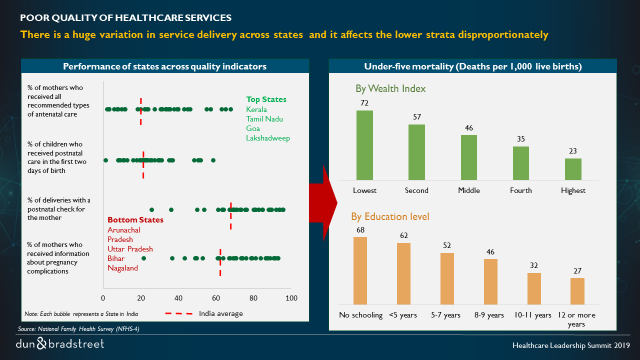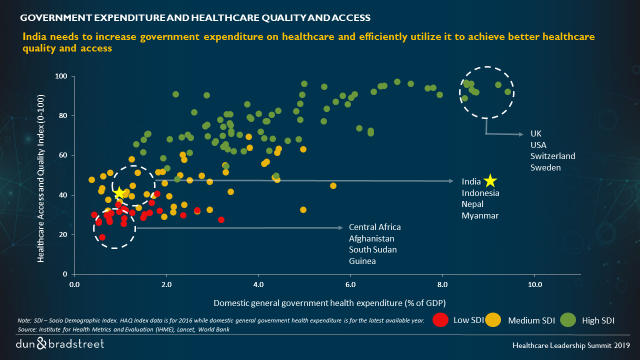Impact Analysis of Union Budget 2020-21 on MSMEs
02-Feb-20
In the year 2017, approximately 56 million people died across the world – which is greater than the World War 2 civilian casualties. There are broadly three categories of casualties. First, mortality due to ageing. Second, preventable mortality and third, mortality due to disease and other causes. While we acknowledge the surge in mortality due to ageing, preventable mortality and mortality due to diseases are two areas of big concerns. Preventable mortality accounted for one-third in share i.e. 18 million deaths. To put it differently, we could have saved them if we had a truly inclusive and quality healthcare system. What we essentially mean by an inclusive and quality healthcare system is that every individual should have physical, financial and informational access to healthcare services. And the healthcare service should be safe, effective, timely, efficient and people-centered.

These principles are very critical for India as we are not just the second most populous country but also on the lower end of the spectrum in ensuring accessible and quality healthcare services. If we unpack the preventable mortality data for the world and look how India fares, the preventable (amenable) mortality rate for India stands at around 1900 deaths per million people (which means 2.4 million people) – twice as high as Thailand, Sri Lanka and even China. When we further unpack and look for the reasons for such a high rate of preventable mortality in India, around two-third of this preventable mortality is due to poor quality of healthcare services and the remaining one-third is due to poor access to healthcare services. Hence, increasing health care coverage would not necessarily result in lower mortalities. There needs to be a commensurate increase in the quality of healthcare services.

Now let us look at the consequences of poor access to healthcare services by looking at two aspects: where we spend and how we spend. Around 40% of the total spend on the healthcare goes towards pharma and drugs followed by hospitalization at 26% and medical consultations at 16%. But when we look at how we finance these medical expenses, around 70% of total expenses is from “Out of Pocket”. Which means every time a person falls sick, he/she has been pushed towards poverty line or below poverty line by that proportion. When we quantify these calculations on a larger framework, “Out of Pocket expenditure” pushes 55 million people in India every year below the poverty line - equivalent to the total population of South Africa. We spend more on medicines and drugs than on hospitalization or medical consultation visits. So if we were to improve access to healthcare services, this is one area where we need to have focused advocacy.

Now coming to the quality of healthcare services, which is another major cause of concern. Add to this, there are the huge variations in service delivery across the states. It is worrying that in a few states, such as Uttar Pradesh (UP) and Bihar, less than 10% of mothers received all recommended types of antenatal care compared to over 60% of mothers in Kerala and Goa. Not surprisingly the under-five mortality rate in UP is 10 times higher than Kerala. If we categorized our population by wealth into quintiles, around 55% of the rural population would fall in the lowest two wealth quintiles. The under-five mortality rate is two times higher in the lowest two wealth quintiles compared to the highest wealth quintile. Similar disparity is observed across education levels. In brief, the mortality rates are very high for lower income group people and the less educated.

The linear relationship between healthcare access & quality and income is observed across countries. As countries move up the league in terms of education and income levels, the healthcare access and quality increases. An important factor in this equation is the level of government expenditure on healthcare. Countries such as the UK, USA and Switzerland which are among the top scorers on the Healthcare Access and Quality Index spend more than five times higher than India on their healthcare system. A steady increase in our public healthcare budget would also bring down the high Out of Pocket expenditure.

To improve our healthcare system, we need to look at healthcare through the lens of economics, public policy and academia, to close the gap between knowledge and execution and to arrive at the appropriate solutions. There are four key areas for action to improve the access and quality of healthcare services in India. Firstly, provide better physical infrastructure and ensure accessibility; Secondly, improve governance or health records to create appropriate policies; Thirdly, improve timeliness of care, standard practices and guidelines; and Lastly, increase the public health expenditure to ease the burden of healthcare finance.

To conclude, we know where we are and most importantly we know how to fix. What we need is just execution.
Dun & Bradstreet, the leading global provider of B2B data, insights and AI-driven platforms, helps organizations around the world grow and thrive. Dun & Bradstreet’s Data Cloud, which comprises of 455M+ records, fuels solutions and delivers insights that empower customers to grow revenue, increase margins, build stronger relationships, and help stay compliant – even in changing times.

Learn what the D-U-N-S Number is and how you can use yours to grow your business.

Make smart credit decisions faster, keep a watchful eye on accounts and monitor portfolio trends. Comprehensive, intuitive and dynamic.

Gain your stakeholders confidence for increased business opportunities and establish your brand credibility.